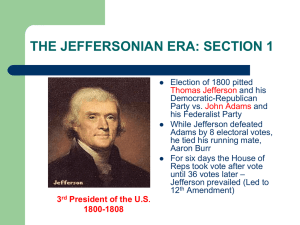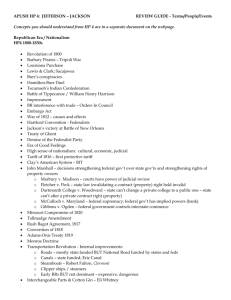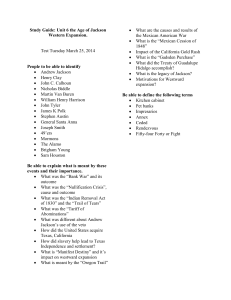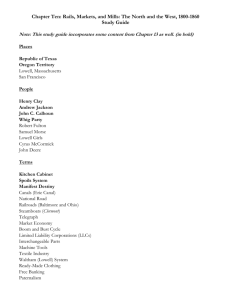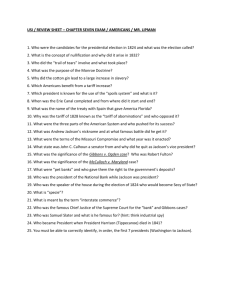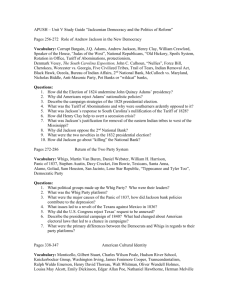PowerPoint - Jessamine County Schools
advertisement
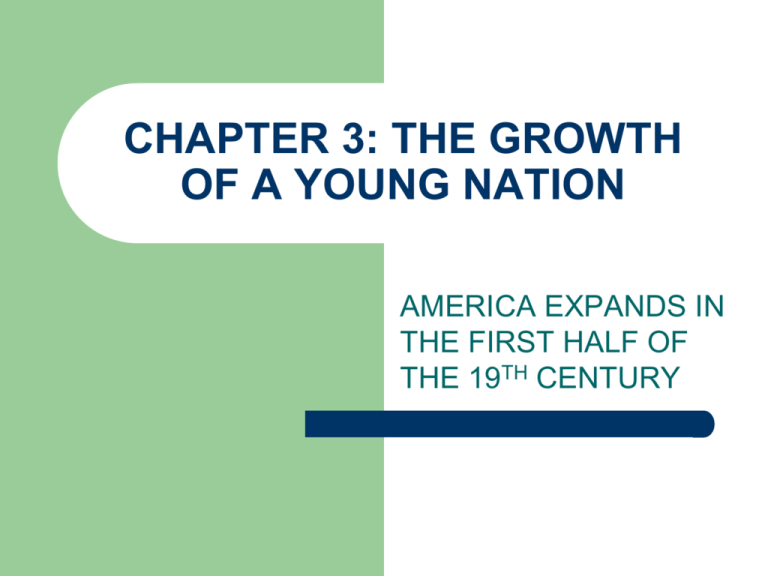
CHAPTER 3: THE GROWTH OF A YOUNG NATION AMERICA EXPANDS IN THE FIRST HALF OF THE 19TH CENTURY SIMPLIFYING THE GOVERNMENT Jefferson’s theory of government, known as Jeffersonian Republicanism, held that simple, limited government was the best for the people Jefferson decentralized the government, cut costs, reduce bureaucracy, and eliminate taxes Jefferson Memorial THE JEFFERSONIAN ERA: SECTION 1 3rd President of the U.S. 1800-1808 Election of 1800 pitted Thomas Jefferson and his Democratic-Republican Party vs. John Adams and his Federalist Party While Jefferson defeated Adams by 8 electoral votes, he tied his running mate, Aaron Burr For six days the House of Reps took vote after vote until 36 votes later – Jefferson prevailed (Led to 12th Amendment) 1800 Election Results SIMPLIFYING THE GOVERNMENT Jefferson’s theory of government, known as Jeffersonian Republicanism, held that simple, limited government was the best for the people Jefferson decentralized the government, cut costs, reduce bureaucracy, and eliminate taxes Jefferson Memorial JOHN MARSHALL AND THE POWER OF THE SUPREME COURT Before leaving office, John Adams (2nd President), attempts to “pack” the Federal courts with Federalists Judges Jefferson argued this was unconstitutional Supreme Court Chief Justice Marshall rules in Marbury v. Madison (1803) that part of the Judicial Act was unconstitutional Established principle of Judicial Review – the ability of the Supreme Court to declare a law unconstitutional THE LOUISIANA PURCHASE By 1803, French leader Napoleon had abandoned his dreams of an American Empire He needed money to fight European wars, so he accepted Jefferson’s offered of $15,000,000 More than doubled the size of our country Lewis and Clark ordered to go explore new territory MADISON ELECTED PRESIDENT 4th President 1808-1816 After two terms, Jefferson is succeeded by James Madison Madison was two-term President 1808-1816 Known as the “Father of the Constitution, Madison also is known for his leadership during the War of 1812 WAR OF 1812 – U.S. vs. BRITAIN Causes: British “impressment” (seizing Americans at sea and drafting them into their navy) upset Americans The War: 1814 – British sack D.C. Burn White house Andrew Jackson leads great victory in New Orleans Treaty of Ghent signed, Christmas Eve, 1814 British Impressment of U.S. seamen upset Americans RESULTS OF WAR OF 1812 Results of the war included: End of the Federalist Party (opposed war) Encouraged industries in U.S. Confirmed status of U.S. as a strong, free, and independent nation Despite the burning of the President’s mansion, the U.S. emerged strong Although the War of 1812 failed to resolve Britain’s violation of American neutral rights on the high seas, how was the outcome advantageous to Americans? A.The British defeat in the Battle of New Orleans boosted American morale. B.The British agreed to stop indicting American slave ships. C.The British departure allowed the U.S. government to initiate treaties with the Indians. D.The British promised to end their support of Tecumseh and other tribal leaders. NATIONALISM SHAPES POLICY James Monroe was elected president in 1816 Immediately, Nationalism clearly established as key concern of administration Treaty with Britain to jointly occupy the Oregon Territory Adams-Onis Treaty (1819) secured Florida & southernmost areas of SE America THE MONROE DOCTRINE In the early 19th Century, various European countries hinted at increased colonization In his 1823 address to Congress, Monroe made it clear to Europe: Don’t interfere with Western Hemisphere (Monroe Doctrine) What idea does this political cartoon convey? THE AGE OF JACKSON: SECTION 2 During a time of growing Sectionalism, Andrew Jackson’s election in 1828, ushered in a new era of popular democracy REGIONAL ECONOMIES CREATE DIFFERENCES The Northeast continued to develop industry while the South and West continued to be more agricultural The Industrial Revolution reached America by the early-mid 19th century New England first to embrace factory system Especially in textile (fabric) mills SOUTH REMAINS AGRICULTURAL Meanwhile, the South continued to grow as an agricultural power Eli Whitney’s invention of the Cotton Gin (1793) made producing cotton even more profitable The South became a “Cotton Kingdom” More labor was needed – 1790 = 700,000 slaves 1820 = 1,500,000 slaves Cotton Gin quickly separated cotton fiber from seeds BALANCING NATIONALISM AND SECTIONALISM Economic differences created political tension between North & South As the regions moved apart, politicians attempted to keep nation together House Speaker Henry Clay’s American Plan called for a protective tariff, a National Bank, and an improved infrastructure to help travel THE MISSOURI COMPROMISE In 1818 settlers in Missouri applied for statehood Northerners and Southerners disagreed on whether Missouri should be admitted as a “free” state Henry Clay organized a compromise in which Missouri was “slave” but Maine would be “free” Also Louisiana Territory split at 36 30’ north latitude HENRY CLAY: THE GREAT COMPROMISER MISSOURI COMPROMISE 1820 ELECTION OF ANDREW JACKSON ANDREW JACKSON IS ON THE $20 BILL Jackson, hero of the common man, won election in 1828 in part because the right to vote had been expanded to more citizens In the 1824 election, won by John Quincy Adams, 350,000 white males voted In 1828, over 1,000,000 white males voted Many of the new voters supported the rugged westerner Jackson who also won re-election in 1832 JACKSONIAN DEMOCRACY As part of his political philosophy, Jackson sought to grant political power to the common people Called The Spoils System or Jacksonian Democracy, Jackson hired his own supporters to replace the previous administration’s staff Jackson gave away many jobs to his friends and political allies INDIAN REMOVAL ACT - 1830 Congress, with Jackson’s support, passed the Indian Removal Act in 1830 Under this law, the federal government funded treaties that forced tribes west The Cherokee Tribe in Georgia refused and were supported by the Supreme Court Jackson refused to abide by the Court decision Jackson said, “John Marshall (Supreme Court Chief Justice) has made his decision, now let him enforce it.” Trail of Tears followed the Court ruling as U.S. troops rounded up the Cherokee and drove them west, mostly on foot. . .thousands died INDIAN REMOVAL - 1830 TARIFF OF “ABOMINATION” THE NORTH TARIFFS THE SOUTH In 1824 and again in 1828, Congress increased the Import Tariff of 1816 Southerners called the 1828 Tariff, “a Tariff of Abominations,” and blamed it for economic problems in the South Tariff of Abominations It was labeled the Tariff of Abominations by its southern critics because of the effects it had on the antebellum Southern economy. The major goal of the tariff was to protect industries in the northern United States which were being driven out of business by lowpriced imported goods by putting a tax on them. The South, however, was harmed directly by having to pay higher prices on goods the region did not produce, and indirectly because reducing the exportation of British goods to the US made it difficult for the British to pay for the cotton they imported from the South. NULLIFICATION THREAT In an attempt to free South Carolina from the tariff, John Calhoun (Jackson’s VP from S.C.), developed the Theory of Nullification He believed if a state found an act of Congress to be unconstitutional, it could declare the law void within its borders Tensions only relieved by a Clay Compromise Tariff in 1833 Nullification Theory Nullification is a constitutional theory that gives an individual state the right to declare null and void any law passed by the United States Congress which the state deems unacceptable and unconstitutional. The concept is most well-known in the context of the sectionalist crisis that plagued the Union in the 40 years preceding the Civil War. JACKSON’S BANK WAR Jackson opposed National Bank so he created Pet Banks – so called because they were favored by Jackson’s Democrats Many felt Jackson was acting more like a King than a president In 1832, his opponents formed a new party – the Whigs PANIC OF 1837 In 1836, Democrat Martin Van Buren won the Presidency He inherited problems from the “Bank Wars” Jackson’s Pet Banks printed money without Gold backing In 1837 a panic set in and many banks closed, accounts went bankrupted, and unemployment soared MARTIN VAN BUREN 1837-1841 HARRISON & TYLER HARRISON 1841 TYLER 1841-1845 Whig William Henry Harrison defeated Democrat Van Buren in the election of 1840 Harrison, known as “Tippecanoe” for a battle he won against natives, died a month into his term His VP, John Tyler became president MANIFEST DESTINY: SECTION 3 In the 1840s Americans became preoccupied with expansion Many believed that their movement westward was predestined by God Manifest Destiny was the belief that the U.S. would expand “from sea to shining sea” UNITED STATES EXPANSION BY 1853 - MANIFEST DESTINY FAMOUS TRAILS WEST No highways existed, thus wagon trails served as the roads to the West Santa Fe Trail ran from Independence, Missouri to Santa Fe, New Mexico Oregon Trail stretched from Independence to Oregon City, Oregon Mormons especially utilized the Oregon Trail on their way to Salt Lake City MEXICO CONTROLS TEXAS After 300 years of Spanish rule, Mexican settlers felt at home in Texas territory Mexico won their independence from Spain in 1821 and Texas was theirs Mexican officials offered land to Americans to make the area more stable Americans soon outnumbered Mexicans in Texas – trouble started TEXAS INDEPENDENCE Stephen Austin established a colony of Americans in Texas Conflicts intensified between Mexicans and Americans in Texas One issue was the slaves many Americans had brought with them Mexico had outlawed slavery in 1829 REMEMBER THE ALAMO THE ALAMO IN SAN ANTONIO Mexican President Santa Anna was determined to force Texans to obey Mexican law Santa Anna marched his troops toward San Antonio – at the same time Austin issued a call to arms for all American Texans American forces moved into a mission known as the Alamo in 1836 After 13 days the Mexican troops scaled the walls and slaughtered all 187 Americans MEXICAN-AMERICAN WAR 1844 presidential election winner, James Polk, eagerly wanted to annex Texas as part of the U.S. Negotiations failed and U.S. troops moved into Mexican territory in 1845 America victories soon followed, and in 1848 Mexican leader Santa Anna conceded defeat Treaty of Guadalupe Hidalgo was signed – U.S. gets (larger) Texas, New Mexico & California MEXICAN PRESIDENT SANTA ANNA CALIFORNIA GOLD RUSH After gold was discovered at Sutter’s Mill, migration to California rose from 400 in 1848 to 44,000 in 1850 Folks who rushed to San Francisco in 1849 became known as Forty-niners By 1857, the total amount of gold mined in California topped $2,000,000,000 THE MARKET REVOLUTION: SECTION 4 The first half of the 19th century in America, brought vast changes to technology, transportation, and production Known as the Market Revolution, people increasingly bought and sold goods rather than make them for themselves A 19th century market NEW INVENTIONS HELP ECONOMY By 1854, 23,000 miles of telegraph wire crossed the country 1837 – Samuel Morse invented the Telegraph Railroads were becoming faster and more numerous by 1830 surpassing canals as # 1 means of transport Robert Fulton invented the Steamboat and by 1830, 200 were on the Mississippi John Deere’s Plow and Cyrus McCormick’s Reaper improved agriculture WORKERS SEEK BETTER CONDITIONS In 1834, Lowell, Massachusetts textile workers went on strike after their wages were lowered – one example of the dozens of strikes in the U.S. in the 1830s and 1840s Several industries formed the National Trade Union in 1834 in hopes of bettering their conditions STRIKES AND UNIONS BECAME MORE NUMEROUS AFTER 1830 The Lowell system was a method of factory management that evolved in the textile mills of Lowell, Massachusetts, owned by the Boston Manufacturing Company. In 1814, the Boston Company built America's first fully mechanized mill in Waltham, Massachusetts. Nine years later, the company built a complex of new mills at East Chelmsford, soon renamed Lowell in honor of the company's founder, Francis Lowell. With the production process fully mechanized, the principal limitation on the firm's output was the availability of labor, and here the company made its second innovation: it began to recruit young farm girls from the surrounding countryside. In order to attract these women and to reassure their families, the owners developed a paternalistic approach to management that became known as the Lowell system. The mill workers were housed in clean, well-run boardinghouses, were strictly supervised both at work and at home, and were paid unusually good wages. The farm girls responded with enthusiasm. They soon became renowned as excellent employees, and their lively self-improvement program (including a literary magazine) drew international attention. Few of the Lowell women worked more than a few years, but for every one who returned home to marry, two new ones appeared. By the 1830s, the Lowell system had become a national symbol of the fact that in America, humanity could go hand in hand with industrial success. Even at the pinnacle of its renown, however, conditions in Lowell had begun to deteriorate. In 1834, an economic downturn led to the mills' first wage cuts. In the 1840s, managers instituted a speedup, requiring higher and higher output for the same hourly wage. The women formed the Lowell Female Labor Reform Association and tried to appeal to their employers and then to the state legislature through petitions. These led to state investigations in 1845 and 1846, but little changed. After 1848, conditions deteriorated further, as New England's textile industry began to suffer from overexpansion. Seeking cheaper labor, the mill owners turned increasingly to Irish immigrants and in the process discontinued the management policies they had devised to attract workers from the farms. By the 1850s, the Lowell system had been abandoned. REFORMING AMERICAN SOCIETY: SECTION 5 The Second Great Awakening spread Christianity through revival meetings Another growing religious group was the Unitarians who emphasized reason as path to perfection Ralph Waldo Emerson was a Unitarian preacher who developed Transcendentalism These and other religions became the impetus for reforming society RALPH WALDO EMERSON Transcendentalism What does “transcendentalism” mean? There is an ideal spiritual state which “transcends” the physical and empirical. A loose collection of eclectic ideas about literature, philosophy, religion, social reform, and the general state of American culture. Transcendentalism had different meanings for each person involved in the movement. Where did it come from? Ralph Waldo Emerson gave German philosopher Immanuel Kant credit for popularizing the term “transcendentalism.” It began as a reform movement in the Unitarian church. It is not a religion—more accurately, it is a philosophy or form of spirituality. It centered around Boston and Concord, MA. in the mid-1800’s. Emerson first expressed his philosophy of transcendentalism in his essay Nature. What did Transcendentalists believe? The intuitive faculty, instead of the rational or sensical, became the means for a conscious union of the individual psyche (known in Sanskrit as Atman) with the world psyche also known as the Oversoul, life-force, prime mover and G-d (known in Sanskrit as Brahma). Basic Premise #1 An individual is the spiritual center of the universe, and in an individual can be found the clue to nature, history and, ultimately, the cosmos itself. It is not a rejection of the existence of God, but a preference to explain an individual and the world in terms of an individual. Basic Premise #2 The structure of the universe literally duplicates the structure of the individual self—all knowledge, therefore, begins with selfknowledge. This is similar to Aristotle's dictum "know thyself." Basic Premise #3 Transcendentalists accepted the concept of nature as a living mystery, full of signs; nature is symbolic. Basic Premise #4 1. 2. The belief that individual virtue and happiness depend upon self-realization— this depends upon the reconciliation of two universal psychological tendencies: The desire to embrace the whole world—to know and become one with the world. The desire to withdraw, remain unique and separate—an egotistical existence. Universal Nature of Man! Who were the Transcendentalists? Ralph Waldo Emerson Henry David Thoreau Amos Bronson Alcott Margaret Fuller Ellery Channing Ralph Waldo Emerson 1803-1882 Unitarian minister Poet and essayist Founded the Transcendental Club Popular lecturer Banned from Harvard for 40 years following his Divinity School address Supporter of abolitionism Henry David Thoreau 1817-1862 Schoolteacher, essayist, poet Most famous for Walden and Civil Disobedience Influenced environmental movement Supporter of abolitionism Amos Bronson Alcott 1799-1888 Teacher and writer Founder of Temple School and Fruitlands Introduced art, music, P.E., nature study, and field trips; banished corporal punishment Father of novelist Louisa May Alcott Margaret Fuller 1810-1850 Journalist, critic, women’s rights activist First editor of The Dial, a transcendental journal First female journalist to work on a major newspaper—The New York Tribune Taught at Alcott’s Temple School Ellery Channing 1818-1901 Poet and especially close friend of Thoreau Published the first biography of Thoreau in 1873—Thoreau, The Poet-Naturalist Resources American Transcendental Web: http://www.vcu.edu/engweb/transcendentalism/index.html American Transcendentalism: http://www.wsu.edu/~campbelld/amlit/amtrans.htm PAL: Chapter Four http://www.csustan.edu/english/reuben/pal/chap4/4intro.html THE ABOLITIONIST MOVEMENT 1820s: Abolitionist movement to free African Americans from slavery arose Leader was a white radical named William Lloyd Garrison Abolitionist called for immediate emancipation of all slaves FREDERICK DOUGLASS: AFRICAN AMERICAN LEADER Freed slave, Frederick Douglass escaped from bandage and became an eloquent abolitionist (critic of slavery) leader He began an anti-slavery newspaper called, Northstar – named after the star that guided runaway slaves to freedom At age 13 he began to look for ways to earn his freedom. He read the Columbian Orator, a collection of speeches dealing with freedom, courage, and democracy. He secretly taught other slaves to read. Frederick was beaten quite often until he started to fight back. He spent time in prison after attempting an escape. He later became an expert as a caulker in a shipyard. Frederick planned his escape north. Arrived in New York City, a free state. “A new world had opened upon me. Anguish and grief, like darkness and rain, may be depicted, but gladness and joy, like the rainbow, defy the skill of pen or pencil.” FD Becoming an abolitionist New Bedford, MA became the new home of Frederick. He changed his name to Douglas in case slave catchers were in the area. He became involved with William Lloyd Garrison’s Liberator. “The paper became my meat and drink. My soul was set all on fire.” This led to his involvement in the abolitionist movement. A skilled lecturer He was anticolonization. Mr. Garrison hired Frederick as a traveling lecturer for the abolitionist movement. The Herald of Freedom reported that Douglas: “has wit, arguments, sarcasm, pathos – all that first rate men show in their master effort.” On the Way to Freedom 1845 Frederick wrote the Narrative of Frederick Douglas, an American Slave. He then traveled to England and continued the antislavery movement. In 1846 Douglas’s freedom was bought for $710.96 and he returned to America. The North Star Newspaper He moved to Rochester, NY and started in own abolitionist paper called the North Star. Founded by Douglass in 1847 He was the editor and publisher of this four page weekly paper. Later became the Frederick Douglass Paper Life in Rochester It took the help of many people and Frederick’s lecture circuit to keep up with the newspaper’s costs. He also helped Susan B. Anthony and Lucretia Mott in the women’s movement. Changing viewpoints Frederick broke with William Lloyd Garrison’s passive movement and joined with John Brown. John Brown taught that “ slaveholders had forfeited their right to live, and that slaves had the right to gain their liberty in any way they could.” Civil War Years Frederick was instrumental in recruiting black soldiers for the Union army. He met with Abraham Lincoln to discuss how to end slavery and was considered to be a good friend of the president. Even after emancipation, Frederick continued the fight for equality. Campaigned for voting rights for both black men and all women. He would move to Washington DC and became involved with political figures. He wrote another book, the Life and Times of Frederick Douglas. Frederick died at the age of 77 in 1895 because of a heart attack. William Lloyd Garrison (focused on evils of slavery in the south and avoiding 'racism' in the North) and Frederick Douglass (attached slavery in the South and racism in the North). TURNER’S REBELLION Turner plans his rebellion The vast majority of AfricanAmericans were enslaved in the South and were subjected to constant degradation Some rebelled against their condition Most famous revolt was led by Virginia slave Nat Turner Turner led 50 followers in a revolt killing 60 whites – he was caught and executed WOMEN AND REFORM From abolition to education, women worked actively in all reform movements Throughout the 1800s opportunity for women to become educated increased 1833: Oberlin College became first coed institution WOMEN’S RIGHTS MOVEMENT EMERGES Reform movements of the 19th century spurred the development of a Women’s movement For example, Elizabeth Cady Stanton and Lucretia Mott had both been ardent abolitionists In 1848, more than 300 women participated in a Women’s Right convention in Seneca Falls, N.Y. Two pioneers in women’s rights: Elizabeth Cady Stanton (left) and Susan B. Anthony
